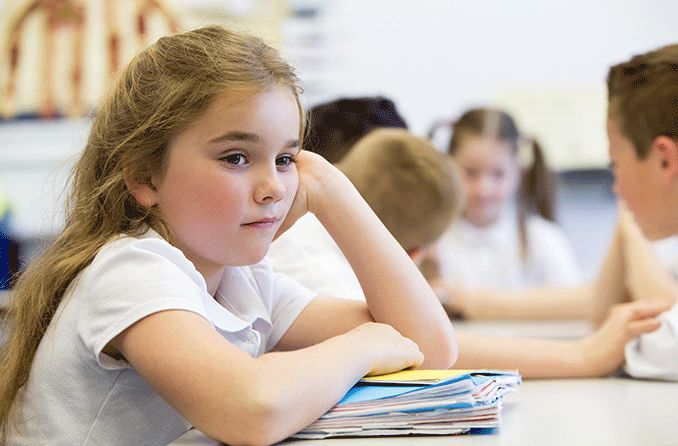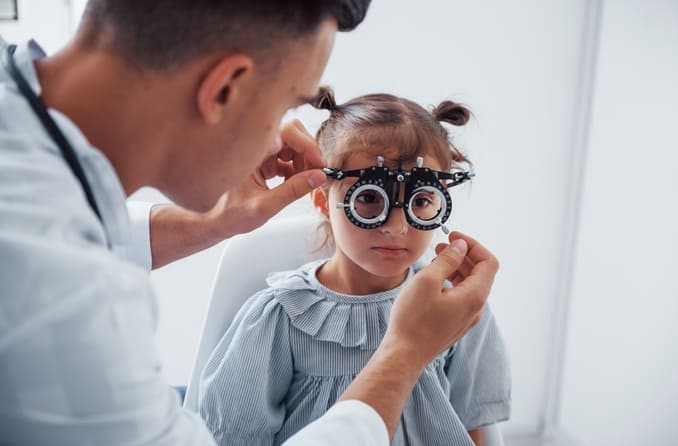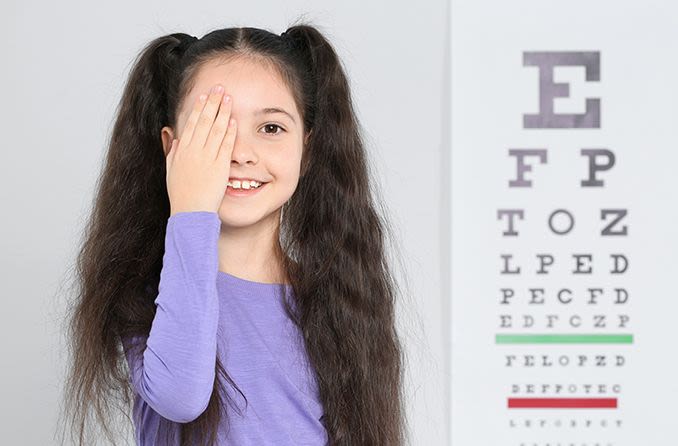It’s natural for parents to want the best for their children: the best health, the best opportunities and the best resources to help them succeed.
One of the most important resources a child has is their vision. However, if a child’s vision is poor, it’s not always easy for them to recognize it and communicate it to their parents or teachers, especially if they’ve had poor vision since infancy.
For this reason, it’s important for parents to keep an eye out for these common signs or behaviors that suggest a vision problem in children.
Rubbing the eyes frequently
An eye infection may cause your child to rub their eyes. If you notice your child rubbing their eyes consistently, check the physical state of their eyes first. Eye redness, puffiness or discharge could mean they have an eye infection such as conjunctivitis.
A lack of symptoms associated with eye infection could mean the rubbing is due to eye strain.
Eye strain is a common result of vision problems like refractive errors. The strain can cause eyes to feel tired or sore, which will prompt your child to rub them.

Squinting
People typically squint their eyes in response to bright light, but squinting can also be a way to improve vision momentarily.
Squinting the eyes changes their shape to make it easier for light to reach the fovea, the part of the eye that produces the best focus. By squinting, we also create a smaller opening to see through, which temporarily improves the clarity of vision.
Children who squint when watching TV or viewing a distant object may have difficulty focusing because of a vision problem.
Closing or covering one eye
It’s possible for a child to have one eye that has worse visual clarity than the other. This is usually the case when a child tries to read using only one eye.
When a child shuts or covers one of their eyes when trying to read, it’s their attempt to create a clearer image. By covering one eye, they’re closing off input from the “bad” eye that produces blurrier vision. It could also be a child’s way of reducing double vision caused by a condition such as strabismus (crossed eyes).
Over time, if the affected eye goes uncorrected, it can weaken and become worse. This may lead to a condition such as amblyopia (lazy eye).
If you notice this habit in your child, it’s important that you take them to see an eye doctor. The earlier the child can have the issue corrected, the easier it will be to correct it.
Tilting or turning the head
Abnormal head positioning is a common sign of a visual impairment. The child may keep their chin up or down, their head tilted to the left or right, or their head turned left or right while their eyes focus straight ahead.
This behavior can be a sign of several eye conditions, including eye misalignment (strabismus), refractive errors, ptosis (droopy eyelid), nystagmus (uncontrolled eye movements) or different visual clarity between eyes.
Viewing TV too closely
While the American Academy of Ophthalmology has debunked the myth that sitting too close to the TV or holding a tablet close to the face can damage a child’s vision, the habit could be a sign of nearsightedness.
Nearsightedness, also called myopia, is a refractive error that makes close-up vision much clearer than distance vision. So, if your child frequently sits close to the TV or or holds a book or tablet very close to their eyes, myopia may be the culprit.
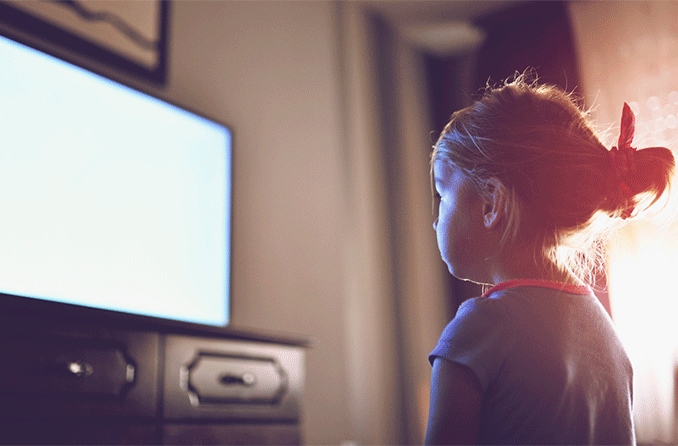
Complaining of dizziness or nausea
Children who often complain of headaches, dizziness or nausea may experience the symptoms because of poor vision.
When the eyes are aligned, they’re able to match up a single image and present it to the brain. In eye misalignment, the brain gets different signals or images from each eye, which produces a double image.
While the brain works to make sense of the double images and fit them together to create a clear picture, the eye muscles are under extra stress. This stress can cause the eyes to shake, resulting in dizziness or light-headedness.
Mistaking words with similar beginnings
If your child often mixes up words that start with similar letters (like the words “perform” and “perfect” or “word” and “work”), it may mean they have faulty visual form perception. Faulty visual form perception means the child cannot discriminate between shape, size or form.
Another sign of faulty visual form perception includes difficulty recognizing different letters, such as “p,” “b” and “q” or “u” and “n.”
Short attention span
It’s often thought that children who have difficulties paying attention have a type of attention deficit disorder. While conditions like ADHD are more prevalent in children with vision problems than in children with normal vision, it’s possible that a vision problem is at the root of your child’s short attention span.
If your child has difficulty reading materials close-up, then school work, coloring or other near tasks will cause eye strain. Also, if your child’s eyes have trouble switching focusing distance, it's difficult for your child to go from looking at the distant whiteboard to the notebook in front of them.
With this in mind, it makes sense that a child would lose interest in vision-oriented tasks. So before you take your child to a doctor for medicine to help them focus, have their vision checked to make sure poor eyesight isn’t the cause of their short attention span.
Difficulty keeping their place when reading
Children who often lose their place or skip lines when reading — either aloud or silently — may do so because of an eye-tracking problem. Typically, the eyes should be able to move or “track” accurately from one point to another.
A child with an eye-tracking problem will often put a finger on the page and move it along as they read. Their finger helps them keep their place.

Struggling with handwriting
Children who have sloppy handwriting or have difficulty coloring within the lines may have faulty visual motor integration. A child with this deficit will struggle with the ability to understand and reproduce visual images through writing or drawing.
It’s also common for children with this problem to be able to respond verbally but not in writing.
Poor hand-eye coordination
While it’s true that many kids are just a little clumsy, a child that regularly bumps into things or has difficulty catching objects that are thrown to them may have a vision problem that affects their depth perception. Vision problems that may affect depth perception include strabismus, amblyopia and certain nerve problems within the eye.
It’s important to note that trouble with hand-eye coordination may also stem from a non-vision-related issue. If a visual deficit is the cause, other vision-related signs will probably also be present.
Reversing or leaving out small words when reading aloud
Having your child read books aloud can help determine visual deficits. Misreading or leaving out small, common words when reading aloud may be a sign of dyslexia.
Dyslexia, from Greek roots meaning “poor language,” is a common learning disability that makes it difficult for a child to read, write and spell. While children with dyslexia are no less intelligent than their peers, they require different teaching approaches to learn most effectively.
Over time, dyslexic people develop strategies to overcome challenges associated with the disability.
SEE RELATED: Dyslexia and vision
Light sensitivity
A study conducted on children with exotropia, a type of strabismus where the eyes turn outward, concluded that over 50% of them experienced light sensitivity (photophobia) or squinting. Sunlight, fluorescent and incandescent lighting can cause photophobia symptoms or squinting and trigger headaches.
If your child seems overly sensitive to light, an eye exam can rule out or diagnose a related vision problem.

Abnormal eye alignment or movement
Eye misalignment is probably one of the more obvious signs of a vision problem in children. This often appears as one of your child’s eyes drifting inward or outward while the other remains focused. A disorder of eye alignment is also called strabismus.
Another similar sign is abnormal eye movement. An example of this is the eyes jerking left or right while the child tries to focus on an object, or seem to drag back and forth across the line of vision like a pendulum. The key feature of abnormal eye movement is that it’s uncontrolled.
Both features can have serious effects on your child’s vision if left untreated. It’s important to see an eye doctor once you notice the signs.
Consistent difficulty distinguishing left from right
While it’s actually fairly common to have occasional trouble distinguishing right from left (approximately one-third of adults have this problem occasionally), extreme difficulty in children can be a symptom of a type of dyslexia.
Known as directional dyslexia, those affected will show an extreme inability to understand the difference between left and right and have a tendency to become disoriented. They may also exhibit trouble with short-term memory.
Avoiding school work, reading or similar tasks
While few children are fans of homework anyway, a child that regularly avoids doing schoolwork, homework or other close-up tasks may struggle with convergence insufficiency.
When we view nearby objects, our eyes naturally move inward (converge) toward our noses in order to focus up close. Convergence insufficiency occurs when the eyes cannot successfully meet in the middle to focus on close objects. This can make working on any up-close tasks difficult.
Avoiding school work could also be because of a learning disability, including dyslexia. If your child’s grades are struggling, it’s important to have their vision checked to ensure a correctable problem isn’t holding them back.
Discoloration of the pupil
If one of your child’s eyes seems to give a white or hazy reflection — particularly around the pupil — it’s important to have their eyes examined by a pediatric ophthalmologist. It could be a sign of retinoblastoma, a type of eye cancer in children.
Retinoblastoma usually affects young children under the age of five and may appear in one or both eyes. While the condition can be treated successfully, early detection is the key.
Moving the head excessively when reading
Moving the head back and forth while reading, watching TV or using the computer may be a sign your child has an eye-tracking problem.
When reading, your child’s eyes should be able to follow the words across the page easily without turning their head. Similarly, when watching TV or using the computer, their eyes should be able to dart to different parts of the screen.
When caught early, tracking problems can be corrected with appropriate treatment.
Excessive tearing
Excessive tearing (epiphora) can be a sign of a couple of eye problems.
Your child could have difficulty closing their eyes completely when they sleep, a condition called lagophthalmos, which dries out the eyes and causes them to water during the day. Consult your child’s eye doctor for treatment options.
Another reason your child has epiphora may be because of a blocked tear duct that keeps the tears from draining properly. Blocked tear ducts can become infected and be very painful, but the infection is easily treated with antibiotics.
Struggling to remember things they read
If your child has problems remembering things they see or read, but has virtually no trouble remembering things they’ve heard or experienced, they may have a faulty visual memory. People who have faulty visual memory struggle to understand or recall things they see.
Other characteristics of this deficit are poor spelling, difficulty in math and trouble remembering information that is presented visually.
Exhibiting low frustration level or has difficulty getting along with others
It’s possible for a child to have 20/20 eyesight and still have a vision deficiency, such as color blindness or dyslexia, which can hinder their ability to learn.
When a child sees classmates completing tasks easily that they themselves find difficult, it can create a low frustration threshold, meaning the child gets frustrated easily. They may also act out, become disruptive, or exhibit behavioral problems as a coping mechanism.
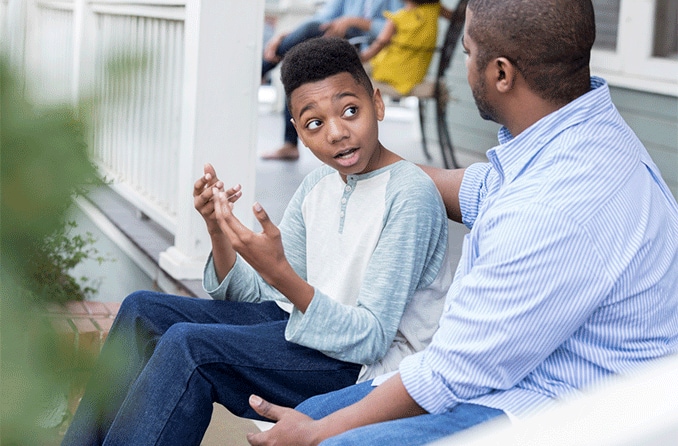
Their eyes appear strange in photographs
If you notice a glare or abnormal haze being reflected from your child’s eyes in photos — particularly when using a flash — it may be a sign that something is wrong.
When the eyes reflect red, the blood-rich retina is being captured in the photo, which is normal. However, if the eye reflection is white, yellowish or black, it could be because of an undiagnosed eye condition such as retinoblastoma.
The best way to capture a potential problem is to take a picture of your child looking directly into the camera. Using the flash in a dimly lit room and turning the “red eye correction” feature off will render the best results.
If there is no red reflection in the photograph, show it to your child’s eye doctor and have them conduct a comprehensive eye exam.
Blinking excessively
Blinking is the eyes’ natural reflex to hydrate the eyes and clear them of any irritants that could affect vision. If your child is blinking excessively, especially when they’re trying to focus on an object, it could be because they cannot see clearly and are blinking to clear their eyes and the image.
Some other reasons your child may blink excessively include conjunctivitis, a scratch on the cornea, intermittent exotropia, allergies or dry eyes. Your child’s eye doctor will be able to diagnose the cause and recommend the right treatment.
READ MORE: Blinking frequency






